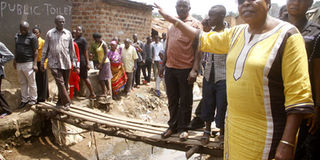Prime
Kamya takes on NWSC over slum sewage spill

Tour. Minister for Kampala Beti Kamya (right) during her tour of Katanga, Kawempe Division that is facing sewage disposal issues. PHOTO BY ABUBAKER LUBOWA
Kampala. Kampala Minister Beti Kamya yesterday told Katanga residents that she would meet the executive director of National Water and Sewerage Corporation (NWSC) to find a lasting solution to the spilling sewage in the area.
The minister’s visit follows an outcry by the residents over the health risk that the spilling sewage presents.
“I want to assure you that I will meet the managing director of NWSC so that a fresh assessment of this area can be made to solve the sewage problem once and for all. After our meeting, I will come back here and report to you the way forward,” she said.
Ms Kamya said the Kampala ministry is ready to partner with NWSC to fix the sewage crisis in order to mitigate health risks.
Katanga slum residents also reported to the minister that some developers around the area do not have a proper sewer system hence they release sewer into the a drainage channel when it rains, something they said urban authorities must thoroughly investigate.
Mr Andrew Ssekayizi, the general manager for Kampala water, noted that residents tend to remove the sewer manhole covers and fill them with garbage which causes backflow of sewage.
“This sewer system in [Katanga] was developed in 2014 and it’s supposed to work for more than 30 years before we can replace it. However, although the sewer pipes were designed to transport only sewer, some people tend to use it to transport garbage,” he said.
Mr Ssekiyizi noted that the Katanga drainage channel overflows into the existing sewer lines.
But Ms Kamya said the plan to construct the Katanga drainage channel is in the offing.
Katanga is part of the Lubigi catchment area. Other areas that fall under this catchment include parts of Mulago, Kalerwe, Bwaise and those on the northern by-pass.
The chairperson of Katanga landlords, Mr Hassan Ssegawa Kambuga, asked government to always first engage local leaders to avoid resistance from residents.


